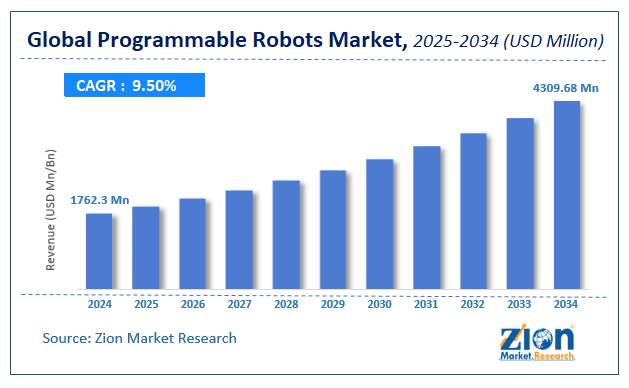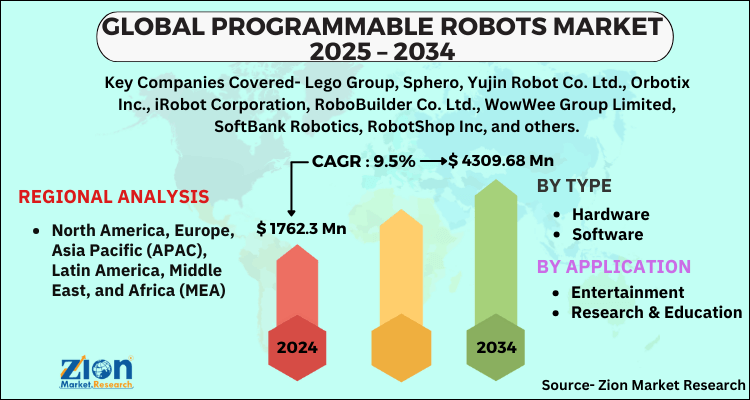Global Programmable Robots Market Size, Share, Growth Analysis Report - Forecast 2034

Programmable Robots Market By Type (Hardware and Software), By Application (Entertainment, Research & Education, and Others), and By Region: Global and Regional Industry Overview, Market Intelligence, Comprehensive Analysis, Historical Data, and Forecasts 2025 - 2034
| Market Size in 2024 | Market Forecast in 2034 | CAGR (in %) | Base Year |
|---|---|---|---|
| USD 1762.3 Million | USD 4309.68 Million | 9.5% | 2024 |
Programmable Robots Market Size
The global programmable robots market size was worth around USD 1762.3 Million in 2024 and is predicted to grow to around USD 4309.68 Million by 2034 with a compound annual growth rate (CAGR) of roughly 9.5% between 2025 and 2034.
The report analyzes the global programmable robots market's drivers, restraints/challenges, and the effect they have on the demands during the projection period. In addition, the report explores emerging opportunities in the programmable robots industry.
Programmable Robots Market: Overview
The programmable robot is an automatic device that functions with the help of remote control or programming language. Such robots are programmable report kits ranging from complex robots like humanoids to single-wheeled robots and PC control to simple remote control robots. These robots further assist in conceptualizing and understanding the subject matter theories of operating and designing a robot. It also helps to effectively program robots with the help of virtual languages like Java, C++, C, and others. Additionally, they also help people in structured thinking for resolving problems.
The programmable robots are deployed for different objectives like education and attainment, and others. Programmable robots assist children in learning all the aspects of engineering, electronics coding, and computer science. One such example is the Addison robot. Robots are a powerful medium to make science, technology, engineering, and mathematics (STEM) education more entertaining for children. These robots offer a learning environment to kids where they can easily connect between what subject matter they are learning and the world revolving around them.
Adoption of robots in research, military, and manufacturing industries, along with use in the educational sector, drives the growth of the programmable robot market. The however high initial cost for the design and development of the robot is the major restraint for the programmable robot market. Moreover, inadequate awareness in the developing countries is also expected to hamper the growth of the market. Nevertheless, constantly ongoing research and development for technological advancements and features is likely to open new opportunities for the programmable robot market in the near future.
Key Insights
- As per the analysis shared by our research analyst, the global programmable robots market is estimated to grow annually at a CAGR of around 9.5% over the forecast period (2025-2034).
- Regarding revenue, the global programmable robots market size was valued at around USD 1762.3 Million in 2024 and is projected to reach USD 4309.68 Million by 2034.
- The programmable robots market is projected to grow at a significant rate due to increasing adoption in education, research, and industrial automation.
- Based on Type, the Hardware segment is expected to lead the global market.
- On the basis of Application, the Entertainment segment is growing at a high rate and will continue to dominate the global market.
- Based on region, Asia-Pacific & North America is predicted to dominate the global market during the forecast period.
Programmable Robots Market: Growth Drivers
Programmable Robots Market: The high adoption rate of programmable robots for educational purposes will spur global market growth
The surging popularity of practical learning will hit the market growth exponentially. Additionally, the evolution of programmable robots has transformed the nature of education for children of all age groups, ranging from kindergarten school to graduate universities. Educational authorities are making initiatives to integrate robotically driven courses in the education curriculums of children at every level. A large number of vendors are increasing their research and development activities to upgrade their understanding of robots for educational purposes.
For instance, Fischertechnik launched a learning environment for understanding the subject matter on Industry 4.0 applications in schools. Apart from this, it will also help understand its research and development components in the IT department, companies, and universities. However, the new product launches are likely to accelerate the market growth. A new programmable robot Luka – the owl was introduced to the market in 2020 by leveraging the power of artificial intelligence. It is said that it can read 50,000 books from a database to children.
Programmable Robots Market: Restraints
Programmable Robots Market: High cost for the development of robots is likely to hamper market growth
The research and development activities in the robot space are quite high. Additionally, the manufacturing cost ultimately makes the final product more expensive. Therefore, it is likely to hinder the growth of the market.
Programmable Robots Market: Opportunities
Programmable Robots Market: Integration of artificial intelligence and the emergence of deep learning systems is likely to create lucrative growth opportunities for the market
The technological advancements and innovations are likely to offer growth in the programmable robot space and make it more viable for them to be adopted for a wide range of purposes. The integration of artificial intelligence along with the emergence of deep learning systems is likely to create lucrative growth opportunities in the forthcoming years. Therefore, the demand for the programmable robot is expected to intensify in the forthcoming years as it can be used for a wide range of services like business assistants, cleaning homes, and others. These robots are known to be a significant asset in the defense military sector for destroying and locating armed explosives.
Programmable Robots Market: Challenges
Time consumption and high complexity are a huge challenge for market leaders.
Developing robots is a time-consuming task. Additionally, the growing complexity requires advanced tools and technology, which is likely to be a challenging factor for market growth.
A robot, which is also called a droid, is a machine, especially one programmable by a computer. A robot is capable of carrying out a complex series of actions automatically. Robots can be guided by an external control device, or the control may be embedded within. Robots may be constructed to take on human form, but most robots are machines designed to perform a task with no regard to how they look.
A robot that can be programmed for a given task and then reprogrammed for others is known as a programmable robot. Each programmed set of steps may involve any number of complex and repetitive tasks, which is also called a reprogrammable robot. Programmable robots are used in programming languages like Java, C, C++, and many others.
Global Programmable Robots Market: Segmentation
The global programmable robots market can be segmented into type, application, and region.
By type, the market can be segmented into hardware and software.
By application, the market can be segmented into entertainment, research, education, and others.
Programmable Robots Market: Report Scope
| Report Attributes | Report Details |
|---|---|
| Report Name | Programmable Robots Market |
| Market Size in 2024 | USD 1762.3 Million |
| Market Forecast in 2034 | USD 4309.68 Million |
| Growth Rate | CAGR of 9.5% |
| Number of Pages | 177 |
| Key Companies Covered | Lego Group, Sphero, Yujin Robot Co. Ltd., Orbotix Inc., iRobot Corporation, RoboBuilder Co. Ltd., WowWee Group Limited, SoftBank Robotics, RobotShop Inc, and others. |
| Segments Covered | By Type, By Application, and By Region |
| Regions Covered | North America, Europe, Asia Pacific (APAC), Latin America, The Middle East and Africa (MEA) |
| Base Year | 2024 |
| Historical Year | 2020 to 2023 |
| Forecast Year | 2025 - 2034 |
| Customization Scope | Avail customized purchase options to meet your exact research needs. Request For Customization |
Recent Developments
- Lego, in Jan 2020, launched its new Spike Prime robotics kit. It was created to introduce middle school-aged students to robotics, engineering, and coding.
- RobotShop.com, in September 2020, introduced a major pivot by ramping up its online activities. It will help robotics product makers and suppliers to sell directly on its e-commerce platform.
Programmable Robots Market: Regional Landscape
North America accounts for the largest share in the global programmable robots market due to the growing demographic dynamics in the education sector. Also, the initiatives of educational authorities to integrate interactive learning courses in the educational curriculum are likely to further complement the growth of the regional market.
Asia Pacific is another leading region in the global programmable robots market due to the growing industrial and education sector in the region.
Programmable Robots Market: Competitive Analysis
The report provides a company market share analysis to give a broader overview of the key market players. In addition, the report also covers key strategic developments of the market, including acquisitions & mergers, new product launches, agreements, partnerships, collaborations & joint ventures, research & development, and regional expansion of major participants involved in the programmable robots market on a global and regional basis.
The global programmable robots market is dominated by players like:
- Lego Group
- Sphero
- Yujin Robot Co. Ltd.
- Orbotix Inc.
- iRobot Corporation
- RoboBuilder Co. Ltd.
- WowWee Group Limited
- SoftBank Robotics
- RobotShop Inc
The global programmable robots market is segmented as follows;
By Type
- Hardware
- Software
By Application
- Entertainment
- Research & Education
- and Others
By Region
- North America
- The U.S.
- Canada
- Mexico
- Europe
- France
- The UK
- Spain
- Germany
- Italy
- Rest of Europe
- Asia Pacific
- China
- Japan
- India
- Australia
- South Korea
- Rest of Asia Pacific
- The Middle East & Africa
- Saudi Arabia
- UAE
- Egypt
- Kuwait
- South Africa
- Rest of the Middle East & Africa
- Latin America
- Brazil
- Argentina
- Rest of Latin America
Table Of Content
Methodology
FrequentlyAsked Questions
The global programmable robots market is expected to grow due to rising adoption in stem education, industrial automation, and research fields, along with advancements in ai and robotics.
According to a study, the global programmable robots market size was worth around USD 1762.3 Million in 2024 and is expected to reach USD 4309.68 Million by 2034.
The global programmable robots market is expected to grow at a CAGR of 9.5% during the forecast period.
Asia-Pacific & North America is expected to dominate the programmable robots market over the forecast period.
Leading players in the global programmable robots market include Lego Group, Sphero, Yujin Robot Co. Ltd., Orbotix Inc., iRobot Corporation, RoboBuilder Co. Ltd., WowWee Group Limited, SoftBank Robotics, RobotShop Inc, among others.
The report explores crucial aspects of the programmable robots market, including a detailed discussion of existing growth factors and restraints, while also examining future growth opportunities and challenges that impact the market.
RelatedNews
HappyClients
Zion Market Research
Tel: +1 (302) 444-0166
USA/Canada Toll Free No.+1 (855) 465-4651
3rd Floor,
Mrunal Paradise, Opp Maharaja Hotel,
Pimple Gurav, Pune 411061,
Maharashtra, India
Phone No +91 7768 006 007, +91 7768 006 008
US OFFICE NO +1 (302) 444-0166
US/CAN TOLL FREE +1 (855) 465-4651
Email: sales@zionmarketresearch.com
We have secured system to process your transaction.
Our support available to help you 24 hours a day, five days a week.
Monday - Friday: 9AM - 6PM
Saturday - Sunday: Closed






